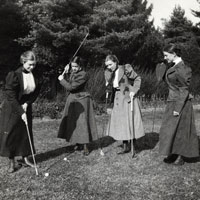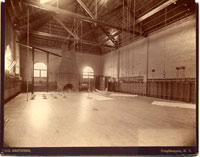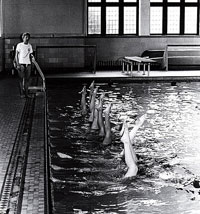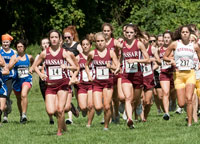The History of Athletics and Physical Education at Vassar College
by By Sarah J. Warner '11 and Kristyn Tempora '12 with additions by Robin Deutsch and Professors Kathy Campbell, Roman Czula, Andy Jennings and Sharon Beverly
March 2011
Department Website
1865-1945
On February 28, 1861 Matthew Vassar met with a group of twenty-eight trustees for the creation of "Vassar Female College." After four years of extensive bickering between trustees, founding family and presidents Milo Jewett and Dr. John Raymond, the college finally opened its doors to 353 young women in the fall of 1865. Despite Matthew Vassar's death a mere three years later, his belief in the importance of "a sound mind in a sound body," or balancing physical education with academics has extended throughout the college's existence.
The first sport implemented at Vassar was "light gymnastics" that taught movement and posture as well as endurance, speed, agility and strength. The location of the current Center for Drama and Film made its mark as the house of the country's first gymnasium at a women's college, the Calisthenium.
In accordance with Matthew Vassar's emphasis on "a sound mind in a sound body," students were required to participate in some form of physical activity for an hour each day, preferably outdoors. This "physical activity" could be fulfilled from walks through the fields surrounding Vassar or more conventionally, through sports. In the late 1800's, Vassar women engaged in student-organized: croquet, archery, skating and tobogganing in the Athletic Circle (now Noyes Circle). For eleven years between 1866 and 1877 baseball also flourished on the campus with as many as seven teams participating. Unfortunately it was discontinued from public censure deeming the sport "plebian."
As the college advanced athletically through the end of the century, in 1876 Vassar funneled students into three groups of athletic ability that determined which sports they could play including basketball and tennis. Tennis was introduced to the United States in 1874 and only five years later arrived at Vassar in 1879. It was immediately popular resulting in a tennis club soon afterwards. The club worked in conjunction with a "greens committee" that cared for the tennis equipment. In 1902, however, field hockey took over Noyes Circle which forced tennis onto the first clay courts where Cushing currently stands. When Cushing was constructed in 1926, the courts moved even further behind Olivia-Josselyn, where newer versions of the courts remain today.
The Alumnae Gym (now Ely) was completed in 1890 and included a marble swimming tank donated by the "good times trustee", Frederick Ferris Thompson. For swimming students wore long black stockings and heavy cotton suits, which they dried by hanging them over the railing between sessions. Alumnae Gym also had large exercise spaces and courts, in addition to forty dressing rooms, twenty-five needle baths (showers) and three water closets. The new gym fueled the students' eagerness to organize themselves into an athletics organization.
The creation of the Athletic Association in 1894 created the financial and administrative means for students to manage all sports outside physical education classes. Students now operated all previously existing sports, and it gave them the leverage to direct new ones such as golf, battle-ball (similar to dodge ball), bicycling and tricycling. This newfound sense of competition made administrators nervous causing them to turn down invitations to compete from other schools. This was evidenced in 1894, when Bryn Mawr College challenged the Vassar tennis club but the administration refused to let the club play, discouraging the competition. As a result there was a decreased interest in tennis until 1896 when the Athletic Association reestablished the club.
Contrary to the administration's discouragement of the event, Harriett Ballintine, head of the physical education department in 1891, helped the Athletic Association organize the first collegiate field day in America. It was held at Vassar in November 1895. The field day was a competition between classes with approximately seventeen girls participating in five track events consisting of the 100-yard dash, 220-yard dash, the running broad jump, and the running high jump.
An article written by Elizabeth Daniels in the Autumn 1995 Vassar Primary Sources Newsletter, shared the following information about the event:
Shielded by trees, with no men present except classics Professor J. Leverett Moore, referee, the students competed in 100- and 200-yard dash, running broad jump, and the running high jump. Basketball, was played between classes in the Circle in the afternoon.
Both the student and public reaction were overwhelmingly positive leading to a second field day scheduled for May of 1896. As a result, the Athletic Association added a "track department" to oversee and organize the field days, also permitting them to expand to include: the standing broad jump, basketball and baseball throws, and the 300-yard relay. More training, participation and enthusiasm led to the continuation of the field day for 40 years. Following the newfound sense of competition, each year the college handed out pink "V's" to the athletes who had broken a school record. These traditions shaped discussions around the appropriate role of women in society that often contended that sports make women healthier and competition builds an important sense of selflessness or "ambition wider than one's ego."
In the early 20th century, Vassar's athletics developed further with the inclusion of field hockey and eventually lacrosse and fencing in the 1920's. Reflective of this development, a separate dining menu was created for student athletes in 1914, to accompany earlier curfews reserved for them. The college created separate tables and menus for the women but the students were disappointed when they found that the special dietary accommodations primarily excluded dessert.
From 1915-1946 Henry Noble MacCracken was Vassar's fifth president and, as an avid tennis player, strengthened the athletic ambiance even further by creating many improvements to the athletics program. He supported the Founder's idea that the benefits of physical education should be incorporated directly into the lives of all students by integrating it as a separate discipline in the liberal arts curriculum in 1923. MacCracken encouraged competition not only intercollegiately, but also through class and dorm teams created in the 1920's and 30's. The Theodore Roosevelt Athletic Cup, established in 1923, was an award vested on the class that received the highest number of points within interclass competition events. Additionally, the Interhall Cup, beginning in 1939 was awarded to the dorm that earned the highest number of points in interdorm competitions. These awards existed through the 50's and 60's until interclass and interdorm competitions ended.
Notably, in the 1920's MacCracken met with the trustees proposing plans for a new gymnasium. In 1933, the year Alice Belding became department chair, MacCracken's vision resulted in Kenyon Hall, furnished with a 75-foot pool, clay courts and an extensive open playing space. The facility was highlighted on the cover of Life Magazine with the caption "Indoor Tennis at Vassar." The article on life at "Vassar Women's College" included pictures of a field hockey player and two students waiting to play indoor tennis. It appeared in the February 1, 1937 issue and was titled, "Vassar : A Bright Jewel in U.S. Educational Diadem."
1937 also saw the beginning of the forty-one-year tenure of Betty Richey as a teacher and coach in the department. Before intercollegiate competition was advocated for women, Richey initiated intercollegiate squash matches between Penn and Wellesley and helped found the Intercollegiate Women's Squash Championship in 1965. Upon Vassar's entrance into intercollegiate competition, she created varsity programs in field hockey, men's and women's squash and tennis. Prior to coaching, Richey was an accomplished athlete. She was a member of the Field Hockey All American team for twenty years and was named for a record twenty-one consecutive years to the Lacrosse All-American team. Richey was cited as the greatest lacrosse player in the nation.
1945-Present Day
In 1946, Henry Noble MacCracken retired from Vassar's presidency and Sarah Gibson Blanding took his place. During her tenure, both the number of teams and the number of students participating in athletics dropped off significantly. By 1967 only six teams remained, compared to the eight teams in previous years. It seemed that the enthusiasm for competition also dwindled. During the 1950's and 1960's, competitions involved "Sports Days," which were very informal competitions between a few schools or club teams. Each school or club would bring different levels of teams for each sport. The school or club would earn points based on the results of competition against their respective level from another school. This competition would usually extend to social events at nighttime, with competing schools staying overnight at the host school, such as Vassar, when Vassar hosted.
1952 saw the arrival of long time department member Jean Appenzellar, who served until 1991. For thirty-six years she coached the Swupper Synchronized Swim Club. It was a common occurrence for over 75 students to tryout for the "swuppers."In 1985 two swuppers finished 6th in the Collegiate National Championship and were asked to tryout for the U.S. National team. Appenzellar chaired the department from 1970-1980.
In 1969, Vassar became a co-educational institution, serving both men and women. This changed quite a few things in the physical education department. Sports Illustrated ran an article in 1971 titled "Best of the Powder Puffs," which stated that Vassar may not be Oklahoma State or Nebraska, but the Big Pink (Vassar) was better than Sarah Lawrence having beaten them in touch football: Vassar Pink 33, Sarah Lawrence Green 24. The two-page article featured a picture. In 1971, Vassar dropped the two-year physical education requirement. Additionally, physical education classes became more educational. Professors would now have to teach sports and coach the teams. Track and Field was started up again in 1972.
There were also a few challenges during this time. It was difficult for Vassar to produce teams that were qualified to compete athletically against other schools, Vassar also had difficulty finding the funding to pay coaches, build new buildings or renovate old ones in order for teams to practice and pay. In both 1975 and 1978 trustee committees met and discussed the weaknesses of the athletics programs and their negative affect on the balance they wished Vassar students to have. The school made many attempts to increase funding, build better facilities and enhance student enthusiasm and interest. In 1976, the "In the Pink" newsletter began, which still exists, in electronic form, today.
In 1981 Vassar joined Division III of the NCAA. John Wallace held the position of "athletic administrator" because the college did not want to use the term "athletics director." Jean Appenzellar had just finished her tenure as department chair and the chair was Bob Colyer (1980-1982). Subsequent to Mr. Wallace, Dick Becker was named Vassar's first "athletics director" in 1981 after serving as interim director. Roman Czula served as department chair from 1982-2004. During this time the department took on the identity of the Department of Physical Education and the Office of Athletics; Andy Jennings served as the Director of Athletics from 1990-2004.
Walker Fieldhouse was built to supplement Kenyon Hall in 1982. Walker sported 42,250 square feet of space, which accommodated various sports such as volleyball, basketball, fencing, badminton and administrative offices. It also contained Kresge Pool, a six-lane swimming facility with a movable bulkhead and diving well, men's and women's locker rooms and an athletic training room. These were drastic improvements to the athletics facilities, however in 1986 President Frances Fergusson was still struggling to improve the athletics program at Vassar. President Fergusson held "Town Hall" meetings to discuss athletics at Vassar and she increased the amount of funding for athletics in her first year. In 1988, she established an athletic advisory committee. The committee determined that the college needed to give more funding to athletics for equipment, transportation and also recommended more full-time coaches. Vassar also needed to improve and expand athletics facilities.
Through the vision of President Fergusson and Athletics Director Andy Jennings, these improvements have come over time. Vassar has competed in the Liberty League, since 1999 (originally the UCAA). In 2000, the Athletics and Fitness Center (AFC) was built. The 53,000 square foot building added to Kenyon Hall and Walker Fieldhouse. The AFC included a 1,200-seat basketball gymnasium, an elevated jogging track, a 5,000-square-foot weight training/cardiovascular facility, administrative offices, a multipurpose room, locker rooms, a laundry/uniform room, and a juice bar. The fitness room contained cardiovascular equipment such as treadmills, stationary bikes, free weights and machine weights. Walker Fieldhouse also received a renovation at that time adding the capability of the multi-purpose space to serve as five indoor tennis courts, the addition of indirect lighting and the expansion of the athletic training room to improve the care of student-athletes. These additions made Vassar's facilities some of the best amongst Division III schools in the country. Subsequently in March of 2003, the J. L. Weinberg Field Sports Pavilion opened giving Prentiss Field six locker rooms and an additional training room and a laundry room.
During mid-2000's the department underwent a re-structuring and emerged as the Department of Athletics & Physical Education in July 2005, with a new emphasis on the importance of intercollegiate athletics competition. The new structure combined the oversight of the two areas (athletics & physical education) under one department head, serving as both the athletics director and chair of physical education, and also gave faculty status to all fulltime head coaches. Andy Jennings retired from administration in June 2004. Kathy Campbell followed Czula as chair from 2004-2005. After serving as interim director, Sharon Beverly became the Director of Athletics & Physical Education in July of 2005, making Beverly the first African American and female, Director of Athletics for the college and the only female African American athletics director in the country in NCAA Division III at a non-historically black institution.
Kenyon Hall experienced a renovation in 2006, providing an innovative space that combined athletics, dance and academics within the same building. Kenyon now contains six international squash courts, a volleyball specific gym, erg room, locker rooms, a satellite athletic training room to add to the sports medicine facilities and Vassar's first varsity weight training facility with Olympic lifting capabilities.
Prentiss Field received a state of the art face-lift in 2008 and became the Prentiss Sports Complex, bringing to fruition the dream of President Fergusson and Jennings. The renovation provided Vassar athletics a traditional baseball field with dugouts, a pristine grass competition field (Gordon Field) and a lighted PureGrass turf field (Weinberg Turf Field), which included a state-of-the-art sandwich synthetic polyurethane 8-lane track augmenting the Weinberg Pavilion. Each facility was equipped with its own press box. Additionally Prentiss Sports Complex added another grass practice field (Taylor Field) in addition to the previous existing grass field. The Prentiss Sports Complex has been called one of the best on the east coast. Track was awarded varsity status in the fall of 2007.
Vassar Athletics experienced financial woes during the end of the 2000s consistent with those of the college and globally. As a result Rowing was moved to a club sport during the fall of 2010. Although now a club sport, consistent with Rugby, it was retained within the athletics program and will continue to flourish.
In the spring semester of 2010, Vassar faculty approved a proposal from the Department of Athletics & Physical Education allowing student-athletes to select academic credit for participation in a department sponsored sport. Critical to the passing of this endeavor was the strong support from student-athletes and the Vassar Student Association (VSA). Student-athletes are now able to receive a half credit a year for participating in their sports.
Today Vassar has developed a very strong athletics program, which includes twenty-three varsity sports, four club teams, outstanding coaches and administrators, a strong physical education curriculum and additional offerings through the life fitness program and intramurals. Athletics facilities consist of the Athletics & Fitness Center, Josselyn Tennis Courts, Kenyon Hall, Prentiss Sports Complex, the Rowing Complex, Vassar Farm and Walker Fieldhouse. The athletics program continues to support the Vassar community, while never losing sight of Matthew's vision of being "students first." Vassar student-athletes have distinguished themselves as Phi Beta Kappas, All-Americans, All-Academics and All-Conference, in addition to other accolades and numerous honors during the past years. The athletics program at Vassar College continues to grow, improve and bring distinction to the institution with teams making NEW history with every coming year.
Resources
"Athletics, 1865-1945." Vassar College Encyclopedia. Vassar College, 2005. Web. 02 Dec. 2010.
"Matthew Vassar.” Vassar College Encyclopedia. Vassar College, 2004. Web. 02. Dec. 2010.
"Calisthenium and Riding Academy (Avery Hall).” Vassar College Encyclopedia. Vassar College, 2005. Web. 02 Dec. 2010.
Daniels, E. A. Autumn 1995. Healthy Minds, Healthy Bodies. Information for Vassar publication: Primary Sources, A Newsletter for Alumnae/i, Parents, and Friends. The Campaign for Vassar College, Office of the President - Vassar College.
"Best of the Powder Puffs." November 1971. Sports Illustrated Magazine.
"Tennis." Vassar College, 2005. Web. 02 Dec. 2010
Field Day. Vassar College Encyclopedia. Vassar College, 2005. Web. 02 Dec. 2010.
"Physical Education," Boxes 1-4, Special Collections, Vassar College Archives.
Vassar: A Bright Jewel in U.S. Educational Diadem. February, 1937. Life Magazine. Retrieved from the World Wide Web on February 1, 2010.
Men's Athletics, 1971. Vassar Encyclopedia.
















